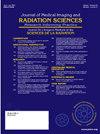Audit of the accessibility, state and cost of computed tomography service: A national audit in a middle-income resource setting
IF 1.3
Q3 RADIOLOGY, NUCLEAR MEDICINE & MEDICAL IMAGING
Journal of Medical Imaging and Radiation Sciences
Pub Date : 2025-05-19
DOI:10.1016/j.jmir.2025.101981
引用次数: 0
Abstract
Background
Computed Tomography (CT) scanners are described as the workhouse of the radiology department. However, their geographical distribution, operationality, availability of skilled personnel and cost of the service may restrict their service to only a few people in some jurisdictions.
Objective
This study audited CT scanners in Ghana to determine their geographical distribution, factors affecting their state and service accessibility to provide data for informed decision-making.
Methods
A survey involving 45 CT centres was conducted between May and August 2021 using a 3-part semi-structured questionnaire. Data collected included equipment characteristics, maintenance support and scheme, CT personnel and examinations. Responses were analysed using Microsoft Excel 2019 and SPSS v. 21. Comparative analyses were made using ANOVA. Downtimes (DT) of CT equipment and corresponding revenue loss were computed. Logistic regression analysis was carried out to determine the odds radio of power control devices (PCD), maintenance support and scheme on downtime. At CI 95 % p < 0.05 was considered statistically significant.
Results
There was a ratio of 1.55 CT scanners to a million population, with only 3 CT centres not included in the survey. Six out of the 16 administrative regions, with 17 % (5 million) of the population had no CT scanners. 22 % of the scanners were non-functioning at the time of the study. 53 % of the centres used PCD and showed a statistically significant relationship with the work setting. There was a cumulative 4356 days DT as at the year 2020 corresponding to an estimated revenue loss of GHc 11,978,692 (USD 2090281.86).
Conclusion
Findings have important policy implications on CT equipment distribution, maintenance and revenue loss due to unplanned downtime. There was low density and disproportionate distribution of the equipment, with more than 1/5 of them non-functioning at the time of the study. The majority of their maintenance was outsourced with 1/3 of the centres employing corrective maintenance policy. While the estimated revenue loss due to unplanned DT was very significant, paradoxically, the service appeared to be unaffordable to many, when the living standards were considered.
Implications for practice
The distribution of CT scanners should be improved and the efficiency of maintenance management systems in CT scanners should be ensured.
计算机断层扫描服务的可及性、状态和成本审计:中等收入资源环境下的国家审计
背景计算机断层扫描(CT)扫描仪被称为放射科的济贫院。但是,它们的地理分布、业务情况、是否有技术人员和服务费用可能会限制它们在某些司法管辖区只向少数人提供服务。目的本研究审核了加纳的CT扫描仪,以确定其地理分布、影响其状态和服务可及性的因素,为知情决策提供数据。方法于2021年5月至8月对45个CT中心进行调查,采用三部分半结构化问卷。收集的数据包括设备特性、维护支持和方案、CT人员和检查。使用Microsoft Excel 2019和SPSS v. 21对回复进行分析。采用方差分析进行比较分析。计算了CT设备的停机时间(DT)和相应的收益损失。采用Logistic回归分析确定了功率控制装置(PCD)的比值比、维修支持和停机方案。在CI 95 % p <;0.05认为有统计学意义。结果每百万人拥有1.55台CT扫描仪,未纳入调查的CT中心仅有3家。在16个行政区域中,有6个区域(占总人口的17% %(500万))没有CT扫描仪。22% %的扫描仪在研究时不能正常工作。53 %的中心使用PCD,并显示出与工作环境有统计学意义的关系。截至2020年,累计DT为4356天,预计收入损失为11,978,692 GHc(2090281.86美元)。结论研究结果对CT设备的分配、维护和意外停机造成的收入损失具有重要的政策意义。设备密度低,分布不均,在进行研究时,有超过1/5的设备不能使用。他们的大部分维修是外包的,三分之一的中心采用纠正维修政策。虽然由于计划外DT造成的估计收入损失非常大,但矛盾的是,当考虑到生活水平时,这项服务似乎对许多人来说是负担不起的。应改善CT扫描仪的分布,确保CT扫描仪维护管理系统的效率。
本文章由计算机程序翻译,如有差异,请以英文原文为准。
求助全文
约1分钟内获得全文
求助全文
来源期刊

Journal of Medical Imaging and Radiation Sciences
RADIOLOGY, NUCLEAR MEDICINE & MEDICAL IMAGING-
CiteScore
2.30
自引率
11.10%
发文量
231
审稿时长
53 days
期刊介绍:
Journal of Medical Imaging and Radiation Sciences is the official peer-reviewed journal of the Canadian Association of Medical Radiation Technologists. This journal is published four times a year and is circulated to approximately 11,000 medical radiation technologists, libraries and radiology departments throughout Canada, the United States and overseas. The Journal publishes articles on recent research, new technology and techniques, professional practices, technologists viewpoints as well as relevant book reviews.
 求助内容:
求助内容: 应助结果提醒方式:
应助结果提醒方式:


